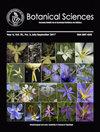Plant community attributes of a tropical dry forest physiognomically dominated by Heteroflorum sclerocarpum (Fabaceae)
IF 0.7
4区 生物学
Q3 PLANT SCIENCES
引用次数: 0
Abstract
Background: Heteroflorum (Fabaceae) is a monospecific genus endemic to western Mexico. Community attributes of the forest where H. sclerocarpum is found are scarcely known, as well as its similarity with other tropical seasonal forests. Question: What is the composition, structure, and diversity of the tropical deciduous forest where H. sclerocarpum is physiognomically dominant? Study site and date: The study was carried out in the buffer area of the Zicuirán-Infiernillo Biosphere Reserve, in the Churumuco municipality of Michoacán, Mexico (2014). Methods: In three 0.1-ha sites, we sampled trees with a diameter at breast height ≥ 1 cm and lianas whose rooted stem had a diameter of ≥ 1 cm. We calculated the density, biomass, rank-abundance, rank-basal area curves, and alpha and beta diversity measures for each site. Results: We recorded 64 species from 21 families in 0.3 ha. Fabaceae had the highest number of genera, species, individuals, and biomass in all sites sampled. The sites varied in richness (33-41 species), density (176-247 individuals), basal area (2-2.9 m2), and maximum height of trees (12-16 m). Rank-abundance curves differed significantly. Rarefaction curves showed that 0Dα and 1Dα did not differ among sites, while 2Dα separated one of the sites, which also showed a different diversity profile. Beta diversity did not show a strong species turnover among sites (0Dβ, 1.38-1.45; 2Dβ, 1.35-1.56). Conclusions: The composition of trees and shrubs in the forest sampled was similar to other seasonal forests, while the density and diversity were among the lowest values.蚕豆科异花属热带干旱林植物群落特征
背景:异花属是墨西哥西部的一个特有属。硬果H.所在森林的群落特征以及与其他热带季节性森林的相似性尚不清楚。问题:硬果H.sclercarpum在地貌上占主导地位的热带落叶林的组成、结构和多样性是什么?研究地点和日期:该研究在墨西哥米却肯州丘鲁穆科市Zicuirán-Infiernillo生物圈保护区的缓冲区进行(2014年)。方法:在三个0.1-ha站点中,我们对胸径直径≥1cm的树木和根茎直径≥1cm的藤本植物进行采样。我们计算了每个站点的密度、生物量、秩丰度、秩基底面积曲线以及α和β多样性测量。结果:我们记录了0.3公顷21科64种。在所有采样点中,蚕豆科的属、种、个体和生物量数量最高。这些地点的丰富度(33-41种)、密度(176-247个个体)、基底面积(2-2.9平方米)和最大树木高度(12-16米)各不相同。秩-丰度曲线差异显著。稀疏曲线显示,0Dα和1Dα在不同位点之间没有差异,而2Dα分离了其中一个位点,这也显示出不同的多样性特征。β多样性在不同地点之间没有表现出强烈的物种更替(0Dβ,1.38-1.45;2Dβ,1.35-1.56)。
本文章由计算机程序翻译,如有差异,请以英文原文为准。
求助全文
约1分钟内获得全文
求助全文
来源期刊

Botanical Sciences
Agricultural and Biological Sciences-Plant Science
CiteScore
1.90
自引率
21.40%
发文量
71
审稿时长
16 weeks
期刊介绍:
Botanical Sciences welcomes contributions that present original, previously unpublished results in Botany, including disciplines such as ecology and evolution, structure and function, systematics and taxonomy, in addition to other areas related to the study of plants. Research reviews are also accepted if they summarize recent advances in a subject, discipline, area, or developmental trend of botany; these should include an analytical, critical, and interpretative approach to a specific topic. Acceptance for reviews will be evaluated first by the Review Editor. Opinion Notes and Book Reviews are also published as long as a relevant contribution in the study of Botany is explained and supported.
 求助内容:
求助内容: 应助结果提醒方式:
应助结果提醒方式:


